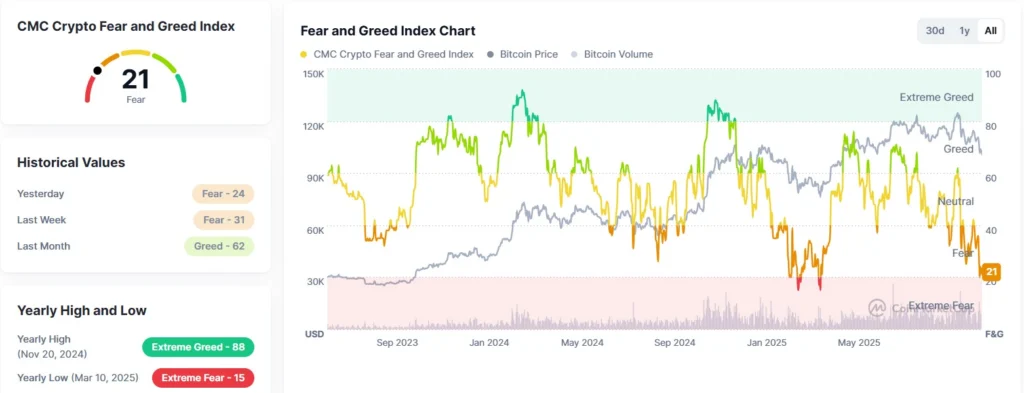
The crypto market entered November under pressure, with major coins retreating and overall sentiment turning cautious.
Bitcoin, once again the market’s barometer, has corrected sharply from its recent highs, reigniting debate over whether this is a healthy pullback or the start of a broader downtrend.
Total crypto capitalization has dropped to multi-month lows, signaling that investors are moving into a defensive stance.
Yet, beneath the surface, new dynamics are shaping the market’s direction. Institutional accumulation is slowing, ETF inflows are stabilizing, and even treasury-style movements from companies like Tether are influencing liquidity. Meanwhile, a few sectors — such as AI-related tokens — are quietly defying the trend.
As November unfolds, the key question is no longer just how far Bitcoin can fall — but what these shifting signals reveal about the next phase of the crypto cycle.
Let’s take a closer look at what made this week so intense for the crypto market.
Bitcoin Drop and Bearish Market Signals at the Start of November

Source: CoinMarketCap
The crypto market began November under heavy pressure, with widespread declines and negative investor sentiment.
According to CoinDesk and Cryptonews data, the total cryptocurrency market capitalization fell about 2.6%, dropping to $3.46 trillion — its lowest level since August. This downturn reinforces the perception that the sector may be entering a bearish market phase.
Bitcoin (BTC), which surpassed $125,000 in October, has fallen more than 20% from its peak, trading between $100,000 and $101,000 between November 5 and 7.
This correction placed the asset in “technical bear market” territory, according to Business Insider.
The Fear & Greed Index, a key market sentiment indicator, plunged to 21 points, signaling a return of “fear” and declining risk appetite.
Macro Analysis and Context
Despite November’s historically strong performance — traditionally one of BTC’s most profitable months — the current landscape remains challenging.
High global interest rates, reduced liquidity, and increased investor risk aversion continue to pressure the market.
Experts suggest this moment may represent a consolidation phase, potentially laying the groundwork for a new bullish cycle — provided there’s an improvement in macroeconomic conditions and a resurgence of institutional inflows.
MicroStrategy Leads BTC Purchases as Institutional Investors Slow Down

Institutional investors remain active in the crypto market, though with less intensity.
MicroStrategy — the world’s largest corporate holder of Bitcoin — acquired 397 BTC during the last week of October, investing approximately $45.6 million at an average price of $114,771 per coin.
This new purchase, made through its subsidiary Strategy, brings the company’s total holdings to over 241,000 BTC, reinforcing founder Michael Saylor’s approach of treating Bitcoin as a primary corporate store of value.
However, the pace of accumulation has slowed compared to previous months — when the company was making near-weekly purchases, taking advantage of liquidity peaks and inflows from newly launched Bitcoin ETFs.
This deceleration suggests a period of institutional consolidation, where major players are shifting focus from aggressive expansion to portfolio management and optimization of their existing BTC positions.
Bitcoin ETFs Maintain Positive Inflows, but Momentum Slows

Spot Bitcoin ETFs continue to attract institutional capital, though at a slower pace.
According to a recent Cryptonews report, U.S.-listed funds recorded net inflows of around $240 million in recent weeks — evidence that institutional interest remains active despite the market’s recent volatility.
Among the leading issuers, BlackRock’s IBIT and Fidelity’s FBTC continue to dominate inflows, strengthening the narrative that Bitcoin is becoming an established investment asset within regulated markets.
However, the pace of new investments has slowed compared to earlier months, when newly approved ETFs generated billions of dollars in inflows within weeks.
This deceleration reflects a phase of institutional caution, driven by macroeconomic pressures such as high U.S. interest rates and reduced risk appetite among investors.
In essence, institutional accumulation persists, but at a milder rate — reducing the strong buying support that previously helped keep Bitcoin’s price above $110,000.
What This Means for the Crypto Market
The steady presence of positive ETF inflows shows that structural interest in Bitcoin remains intact — it has merely stabilized after the initial wave of enthusiasm.
Analysts interpret this as a market consolidation phase, where long-term investors hold their positions while short-term traders take profits.
If macroeconomic conditions improve — especially with potential interest rate cuts in 2026 — Bitcoin ETFs are expected to reignite demand and restore a stronger pace of institutional inflows.
Macroeconomic Outlook and November Seasonality: Cautious Optimism Ahead

Source: coinmarketcap
The recent decline in Bitcoin’s price comes amid a climate of caution across global markets, heavily influenced by tight monetary policies and lower international liquidity.
According to the same CoinDesk report, investors are adjusting their positions in response to the Federal Reserve’s firm stance on maintaining high interest rates to curb inflationary pressures.
This policy directly impacts risk assets, including cryptocurrencies, as elevated rates reduce speculative and institutional capital flows into the sector.
Despite these challenges, November has historically been Bitcoin’s best-performing month.
Data from Cointelegraph shows that since 2013, Bitcoin has posted an average gain of around 42.5% in November — driven by cyclical optimism and new inflows of capital ahead of the year’s end.
However, analysts caution that this seasonal trend doesn’t guarantee an automatic recovery.
Even “the best month on the calendar” depends on favorable macroeconomic conditions, such as:
- A decline in global interest rates
- Improved market liquidity
- Renewed institutional inflows via ETFs and regulated funds
Without these triggers, the market may remain sideways or even deepen its correction, especially if risk appetite continues to shrink.
Outlook for the Remainder of 2025
Bitcoin still has a seasonal window of opportunity for recovery, but any rebound will depend on external factors — monetary policy, global economic performance, and ETF market behavior.
Until macro conditions align, the market is likely to stay in defensive mode, with a focus on capital preservation and long-term positioning strategies.
Tether Moves $100 Million in Bitcoin to Its Reserve Wallet

Tether Limited, the issuer of the USDT stablecoin, transferred approximately $100 million in Bitcoin (BTC) this week to one of its reserve wallets, according to on-chain data reported by The Block.
The move is part of Tether’s ongoing strategy to diversify and strengthen its reserves, which currently include U.S. Treasury bills, gold, and Bitcoin.
The company has been gradually increasing its exposure to BTC since 2023 as a way to enhance liquidity and hedge against inflation and currency risks.
However, these treasury-style movements often draw attention due to recurring debates over Tether’s transparency—particularly regarding the exact composition of the reserves backing USDT, the world’s largest stablecoin by market capitalization.
Investors and analysts closely monitor these crypto treasury operations because they can influence market liquidity and affect short-term Bitcoin volatility.
According to the company’s latest quarterly report, about 8.6% of Tether’s reserves are now allocated to Bitcoin, cementing BTC as one of the core assets in its reserve portfolio.
AI Tokens Show Resilience in the Crypto Market

Source: Decrypt
While most of the crypto market saw sharp declines, AI-related tokens managed to outperform, showing stronger stability and even slight weekly gains.
According to CoinDesk, tokens such as Render (RNDR), Fetch.ai (FET), SingularityNET (AGIX), and Akash Network (AKT) demonstrated lower volatility and above-average performance, defying the broader correction affecting major cryptocurrencies.
This resilience among AI tokens highlights continued investor interest in tech-driven narratives with real-world applications, particularly projects combining blockchain, decentralized computing, and artificial intelligence.
The convergence of these technologies is creating new market opportunities, such as distributed data processing and AI model marketplaces, which are attracting both developers and venture capital.
Moreover, the positive performance of thematic projects reinforces that the crypto market doesn’t move uniformly.
Even during downturns, sectors with tangible utility or strong technological storytelling tend to retain investor attention.
This signals growing market maturity, as capital increasingly flows toward projects with fundamental value rather than pure speculation.
What This Trend Suggests
The outperformance of AI tokens suggests that thematic diversification within the crypto market could become an effective strategy.
While Bitcoin and major altcoins face macroeconomic pressure, niche projects with technological innovation may continue to grow independently — pointing to an increasingly segmented and sophisticated ecosystem.
Dogecoin (DOGE) in Focus: Hodlers Exit and Technical Support at Risk

Source: Invezz
Dogecoin (DOGE) has returned to the spotlight after on-chain data revealed a significant shift among long-term holders.
According to ZyCrypto, the Hodler Net Position Change — a metric tracking the net balance of coins in older wallets — turned negative on October 31, indicating that veteran investors are reducing their positions.
In total, 22 million DOGE were moved out of long-term wallets, while only 8.2 million DOGE entered new positions.
This imbalance suggests profit-taking and supply redistribution, which could add short-term selling pressure.
On the charts, Dogecoin is struggling to hold the $0.18 support level, a key technical threshold to avoid further declines.
If this level breaks, analysts warn of a potential correction toward $0.175, a secondary support zone.
However, trading volume and the rise in active addresses suggest that short-term traders are attempting to stabilize the price, betting on a possible rebound if the support level holds.

